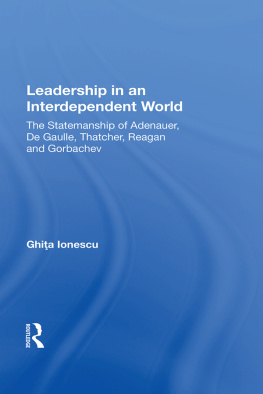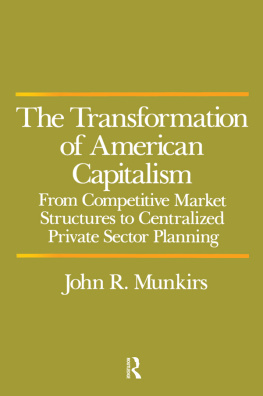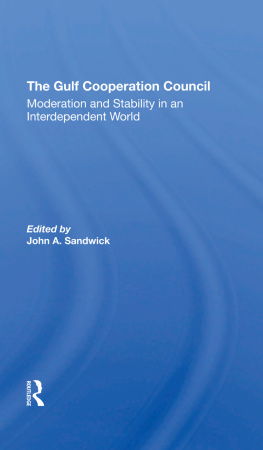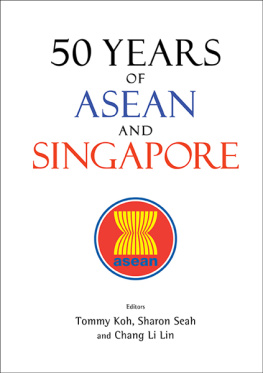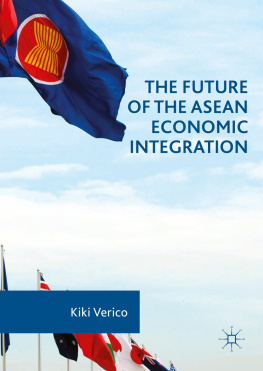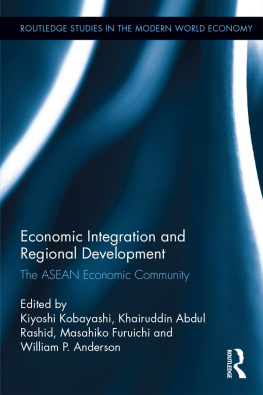ASEAN IN AN INTERDEPENDENT WORLD
To the progressive rock lovers, research fanatics and all the other staff members, in the economics department.
ASEAN in an Interdependent World
Studies on trade and finance
Edited by
MUZAFAR SHAH HABIBULLAH
Department of Economics
Universiti Putra Malaysia
Malaysia
First published 2000 by Ashgate Publishing
Reissued 2018 by Routledge
2 Park Square, Milton Park, Abingdon, Oxon, OX14 4RN
711 Third Avenue, New York, NY 10017, USA
Routledge is an imprint of the Taylor & Francis Group, an informa business
Copyright Muzafar Shah Habibullah 2000
All rights reserved. No part of this book may be reprinted or reproduced or utilised in any form or by any electronic, mechanical, or other means, now known or hereafter invented, including photocopying and recording, or in any information storage or retrieval system, without permission in writing from the publishers.
Notice:
Product or corporate names may be trademarks or registered trademarks, and are used only for identification and explanation without intent to infringe.
Publishers Note
The publisher has gone to great lengths to ensure the quality of this reprint but points out that some imperfections in the original copies may be apparent.
Disclaimer
The publisher has made every effort to trace copyright holders and welcomes correspondence from those they have been unable to contact.
A Library of Congress record exists under LC control number: 00134830
ISBN 13:978-1-138-74183-6 (hbk)
ISBN 13:978-1-315-18226-1 (ebk)
Contents
Ahmad Zubaidi Baharumshah
Cheng Ming Yu and Tan Hui Boon
Tan Hui Boon
Mohamed Sharif Bashir and Zakariah Abdul Rashid
Muzafar Shah Habibullah, Ahmad Zubaidi Baharumshah, M. Azali and W.N. W. Azman-Saini
Law Siong Hook and Tan Hui Boon
W.N. W. Azman-Saini and M. Azali
Muhd Zulkhibri Abdul Majid and Mohammed B. Yusoff
Shazali Abu Mansor and Alias Radam
M. Azali, Department of Economics, Faculty of Economics and Management, Universiti Putra Malaysia, 43400 UPM Serdang, Selangor, Malaysia; azali@econ.upm.edu.my
W.N.W. Azman-Saini, Department of Economics, Faculty of Economics and Management, Universiti Putra Malaysia, 43400 UPM Serdang, Selangor, Malaysia.
Ahmad Zubaidi Baharumshah, Department of Economics, Faculty of Economics and Management, Universiti Putra Malaysia, 43400 UPM Serdang, Selangor, Malaysia; zubaidi@econ.upm.edu.my
Mohamed Sharif Bashir, Department of Economics, Faculty of Economics and Management, Universiti Putra Malaysia, 43400 UPM Serdang, Selangor, Malaysia.
Tan Hui Boon, Department of Economics, Faculty of Economics and Management, Universiti Putra Malaysia, 43400 UPM Serdang, Selangor, Malaysia; tanhb@econ.upm.edu.my
Muzafar Shah Habibullah, Department of Economics, Faculty of Economics and Management, Universiti Putra Malaysia, 43400 UPM Serdang, Selangor, Malaysia; muzafar@econ.upm.edu.my
Law Siong Hook, Department of Economics, Faculty of Economics and Management, Universiti Putra Malaysia, 43400 UPM Serdang, Selangor, Malaysia; lawsh@econ.upm.edu.my
Muhd Zulkhibri Abdul Majid, Central Bank of Malaysia, Kuala Lumpur, Malaysia; muhamedz@bnm.gov.my
Shazali Abu Mansor, Department of Economics, Universiti Malaysia Sarawak, Sarawak, Malaysia; mshazali@mailhost.unimas.my
Alias Radam, Department of Agribusiness and Information System, Faculty of Agriculture, Universiti Putra Malaysia, 43400 UPM Serdang, Selangor, Malaysia; alias@econ.upm.edu.my
Zakariah Abdul Rashid, Department of Economics, Faculty of Economics and Management, Universiti Putra Malaysia, 43400 UPM Serdang, Selangor, Malaysia; zar@econ.upm.edu.my
Cheng Ming Yu, Faculty of Management, Universiti Multimedia Malaysia, 63100 Cyberjaya, Selangor, Malaysia; mychen@mmu.edu.my
Mohammed B. Yusoff, Department of Economics, Faculty of Economics and Management, Universiti Putra Malaysia, 43400 UPM Serdang, Selangor, Malaysia; mby@econ.upm.edu.my
This book contains 9 selected applied economic papers presented during the 1999 Faculty of Economics and Management Seminar in Melaka, Malaysia. The articles included in this book focus on studies on trade and finance in Malaysia and other ASEAN member countries.
We thank all the participants at the seminar for their constructive comments and suggestions and also to all individuals who have contributed in one way or another in the preparation of the manuscripts. Also, we would like to express our thanks to Alias Radam and Azman-Saini for their help and assistance on the technical aspect of this book.
Last but not least, we thank Universiti Putra Malaysia for providing financial support for research undertaken at UPM.
Muzafar Shah Habibullah
Universiti Putra Malaysia
Ahmad Zubaidi Baharumshah
Introduction
There are several theories regarding the effect of devaluation on trade balance. The elasticity approach to exchange rate (Krueger, 1983) suggested that transactions completed at the time of devaluation or depreciation may dominate a short-term change in the trade balance. That is, there is an initial deterioration in the trade balance during the contract period before quantities of exports and imports adjust.1 Over time, elasticities of exports and imports increase, quantities adjust to the altered effective prices, and the trade balance improves. Williamson (1983), however, points out that higher import prices caused by devaluation, can contribute to higher domestic prices of non-traded goods. The resulting overall inflation raises the effective real exchange rate, perhaps eliminating the potential for increasing the trade balance. According to the monetary approach to exchange rate, a devaluation or depreciation decreases the real supply of money, thus, increases domestic money demand. This leads to hoarding and an increase in the trade balance.
In theory, currency devaluation or depreciation affected the trade balance in two ways: a devaluation of the real exchange rate and a direct effect on the domestic absorption. Firstly, nominal devaluation is assumed to affect real exchange rate (a relative price) and thus improve competitiveness. This in turn improves the trade balance, ceteris paribus. The second channel is related to the absorption effect on devaluation. In a world in which all goods and assets are perfect substitutes, prices are exogenously determined for a small country case. Wages and prices are flexible both in nominal and real terms and devaluation will increase the price level by the same percentage. The increase in price level reduces real balances and thus domestic absorption.
It is not uncommon to find in the macroeconomic literature arguments for and against devaluation. Empirical studies on the trade balance-exchange rate relation have utilised different methodologies to address this issue. Nevertheless, the empirical results from all these studies are inconclusive. Gylfason and Risager (1984: Table 3) used parameter estimates of a general macro model to show that devaluation improves the current accounts in LDCs. Bahmani-Oskooee (1986: Tables 28) estimated price elasticities through import and export demand models and showed that they are high enough to warrant improvement in trade balance. On the other hand, Laffer (1977), Miles (1979) and Marquez (1990) have all concluded exactly the opposite. For instance, Marquez (1990) used band spectrum analysis and estimated bilateral trade elasticities from which multilateral trade elasticities were estimated. By grouping the LDCs in one category, she showed that their trade elasticities (that is, sum of import and export price elasticities) to be 0.78, not enough for successful devaluation.2





